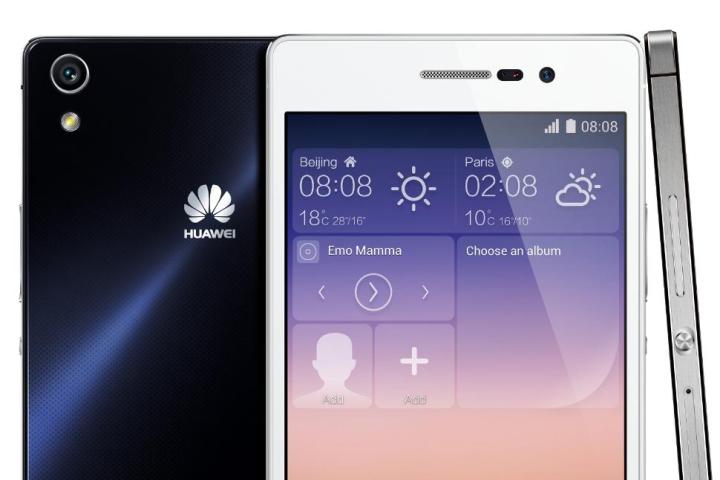
Huawei has launched the Ascend P7, its 2014 flagship Android phone, and the follow-up to the Ascend P6 and P6S. It chose the city of Paris to hold its event, a fitting location given the phone’s sleek and fashionable style. Presented by CEO Richard Yu, the Ascend P7 follows the P6’s slim design and measures just 6.5mm thick. The phone is wrapped in an aluminum chassis with Gorilla Glass panels on the front and rear. The glass back covers a neat pattern, which Huawei calls the “spin effect,” giving it an almost laser-cut look.
The Ascend P7 has a 5-inch, 1080p touchscreen with a 445ppi pixel density, up from the 4.7-inch, 720p panel found on the Ascend P6. Powering the phone is a quad-core, 1.8GHz Kirin 920T processor, which is also used in the MediaPad X1 tablet revealed during Mobile World Congress. Around the back of the phone is a 13-megapixel camera sourced from Sony, while the front camera is better than many rear cameras found on other devices. It has a whopping 8-megapixels, a 5-piece lens, and can even shoot panoramic photos and 1080p video.

Continue on to page 2 for a recap of all the rumors and news surrounding the Ascend P7 prior to its announcement.
Information on Huawei’s next flagship phone, currently known as the Ascend P7, continues to leak. The smartphone is expected to replace the Ascend P6 and its subtly updated sister device, the Ascend P6S, as the company’s 2014 flagship
When will Huawei announce the P7?

Huawei’s Ascend P6 came out in June last year.
What will it look like?
A set of pictures have been leaked, supposedly showing the Ascend P7 in some press-style glamor shots. We’d already been told not to expect drastic design alterations, and sure enough, things looks pretty similar to the Ascend P6. It’s not terrible news though, and the phone looks very attractive in the images, particularly when viewed from the back. The rear panel shines and seems to have a very subtle pattern laser etched into it. A camera lens and flash unit sit in the top left.

Around the front and to the sides, the white phone does bear a similarity to the Apple iPhone. Huawei has also taken some inspiration from Sony, and included a new, recessed, circular power button, set mid-way down the side. It’s joined by a volume rocker control, and a pair of card trays, one for the SIM and the other presumably for a MicroSD card.
If this is the final design for the Ascend P7, we think it looks great.
Leaked specs show improvements over the Ascend P6
Early news on the P7’s spec comes from the @evleaks Twitter account. The most notable spec change over the P6 is to the screen, which should be enlarged to 5-inches, and the resolution raised to 1080p. This is up from 4.7-inches and 720p on the older model. The processor should also be upgraded. The leak mentions a quad-core, 1.8GHz chip called the 910T Kirin. This is a processor of Huawei’s own design, and has recently been seen in the MediaPad X1 tablet. It’s likely to be accompanied by 2GB of

If the leak is accurate, the rear camera could have 13-megapixels, while the front camera will be increased beyond the trending 5-megapixel level, all the way up to 8-megapixels. Selfie fans should adore this one. It’s also mentioned the Ascend P7 should have 16GB of internal memory, plus a MicroSD card slot to increase this further.
The Ascend P6 is one of the slimmest phones you can buy, at just 6.18mm, and although the new leak doesn’t specifically mention the P7’s dimensions, it does say the chassis will measure less than 7mm thick. Huawei may fit a larger battery inside the device – 2500mAh instead of 2000mAh – so it may not be quite as svelte as its predecessor.
Updated on 02-05-2014 by Andy: Huawei has confirmed it will hold a press event on May 7 in Paris.
Article originally published on 04-25-2014


